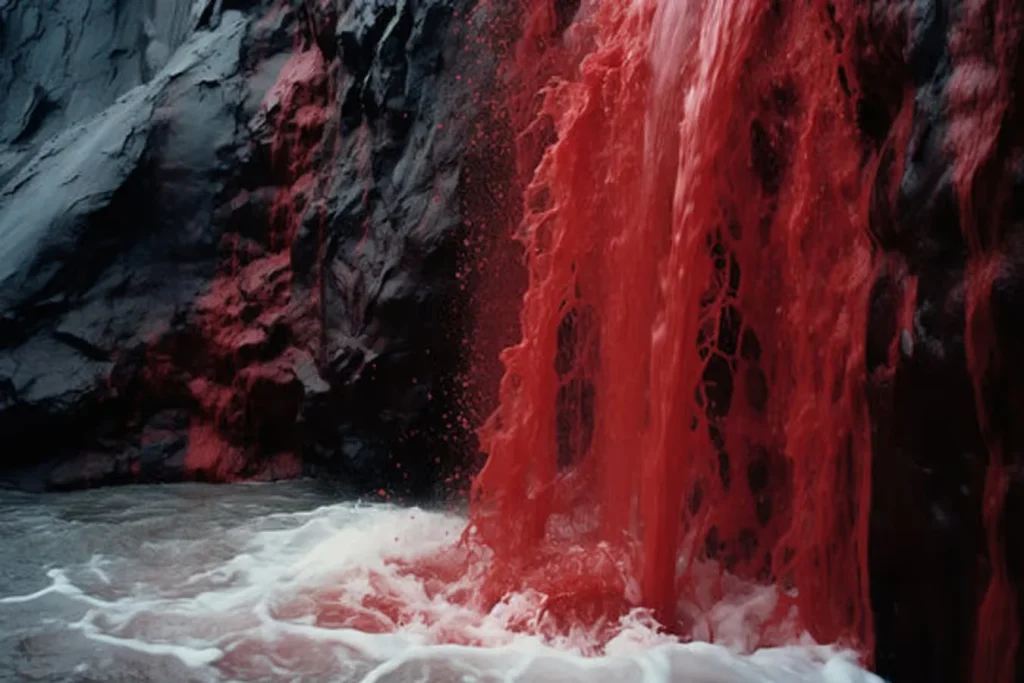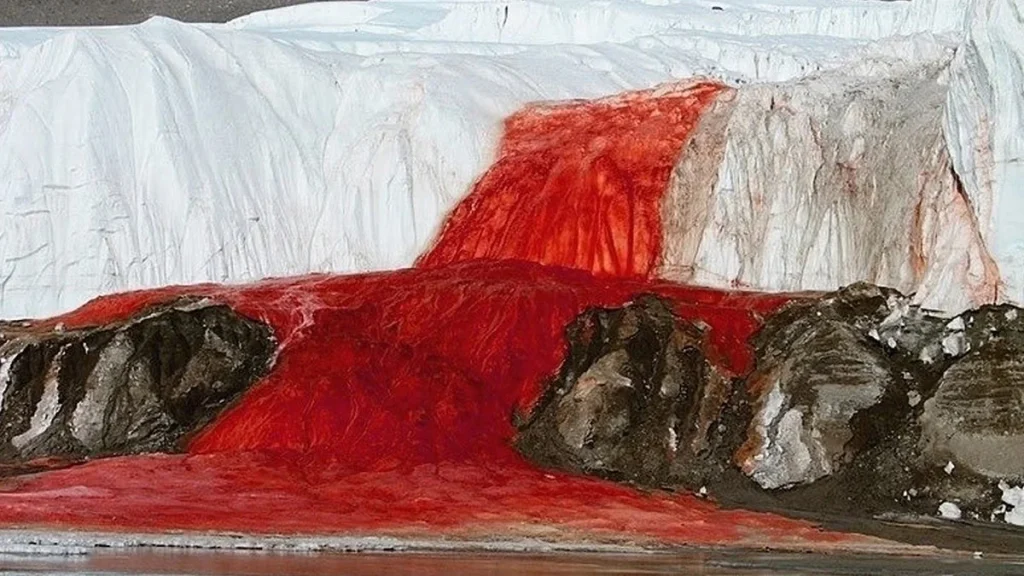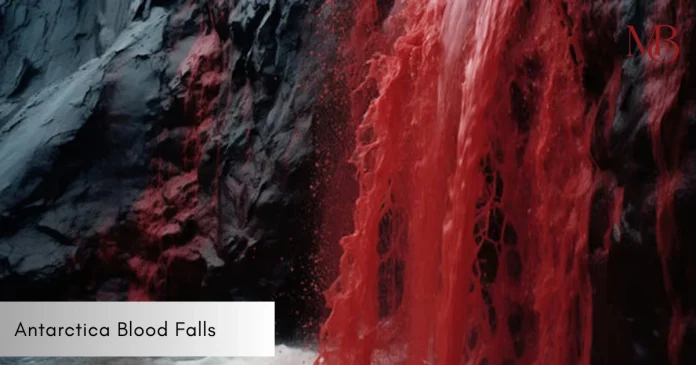Have you ever heard of a glacier that bleeds? No, this isn’t a scene from a horror movie. This is real. Deep in the icy wilderness of Antarctica, a rust-colored waterfall seeps out of a frozen glacier, staining the pristine white landscape with streaks of crimson. This eerie phenomenon, known as Antarctica Blood Falls, has baffled scientists and explorers for over a century.
What makes this frozen landscape appear to bleed? What hidden world lies beneath its ancient, icy layers? Join us as we unravel the chilling enigma of Blood Falls!
Where is Blood Falls Located?
Tucked away in the Taylor Valley of East Antarctica’s McMurdo Dry Valleys, Blood Falls is an outflow from the Taylor Glacier. The McMurdo Dry Valleys are some of the most extreme deserts on Earth, experiencing almost no rainfall and freezing temperatures that can drop to -19.8°C.

Unlike most of Antarctica, where glaciers are covered in thick snow and ice, this valley is mostly ice-free due to strong, dry katabatic winds. These winds reach speeds of 320 km/h, evaporating all moisture and preventing snow from settling. In the heart of this frozen wasteland, Blood Falls emerges from the terminus of Taylor Glacier, spilling into the ice-covered Lake Bonney.
| Location | Details |
| Continent | Antarctica |
| Region | East Antarctica |
| Valley | Taylor Valley (McMurdo Dry Valleys) |
| Glacier | Taylor Glacier |
| Outflow Into | Lake Bonney |
Why is Blood Falls Red?
For years, scientists speculated about the deep red color of Blood Falls. Early explorers thought it was caused by red algae, but that theory was quickly debunked. The real reason? Iron-rich, hypersaline water.
This underground water, trapped beneath the glacier for millions of years, is three times saltier than seawater and rich in iron. When it reaches the surface, the iron in the water reacts with oxygen, forming iron oxide—the same process that gives rust its reddish color.
So, in a way, Blood Falls is a giant, natural rusty faucet, slowly leaking its secrets to the world.
The Hidden World Beneath Blood Falls
The real mystery of Blood Falls isn’t just its color. It’s what lies beneath. Scientists have discovered that this eerie waterfall is a portal to an ancient subglacial world, sealed off from the rest of the planet for over 2 million years.
- The water emerges from a subglacial lake buried 400 meters beneath the glacier.
- It is completely devoid of sunlight and oxygen.
- Yet, it is teeming with ancient microbial life!
These microbes, trapped under extreme conditions, survive by using iron and sulfur as their energy source. This is similar to how life might exist in extreme environments on Mars or Europa, one of Jupiter’s icy moons!

The Formation of Blood Falls
The origins of Blood Falls date back to a time when Antarctica was not the frozen wasteland it is today. Here’s how this incredible phenomenon formed:
| Time Period | Event |
| 5 Million Years Ago | Rising sea levels flooded East Antarctica, forming a salty lake. |
| 3 Million Years Ago | Glaciers formed over the lake, trapping the saltwater underneath. |
| 2 Million Years Ago | The subglacial lake became completely isolated, preserving microbial life. |
| Today | The brine slowly seeps through fissures in Taylor Glacier, creating Blood Falls. |
Why Doesn’t Blood Falls Freeze?
One of the biggest mysteries of Blood Falls is why the water doesn’t freeze, despite the extreme cold of Antarctica. The answer lies in its hypersalinity.
- Normal water freezes at 0°C, but highly saline water has a much lower freezing point.
- The brine in Blood Falls is so salty that it can stay liquid at -10°C to -20°C.
- When the brine moves through the glacier, it releases latent heat, slightly melting the surrounding ice.
This unique combination allows Blood Falls to continue flowing like a slow, icy wound, despite the frigid Antarctic climate.
Why is Blood Falls Important?
Blood Falls is more than just a creepy, bleeding glacier. It holds clues to ancient microbial life and could help scientists understand:
- The History of Earth’s Climate – Studying the brine can reveal how Antarctica’s climate has changed over millions of years.
- Life in Extreme Conditions – The microbes in Blood Falls survive without oxygen or sunlight, proving that life can exist in harsh environments.
- Possibility of Life on Other Planets – If life can survive under Antarctica’s glaciers, could similar life exist on Mars or Jupiter’s moons?
Who Discovered Blood Falls?
Blood Falls was first discovered in 1911 by Thomas Griffith Taylor, an Australian geologist on Robert Falcon Scott’s famous Terra Nova Expedition. Imagine stumbling upon a blood-red waterfall in the middle of an icy desert! It must have been a shocking sight for Taylor and his team.
Should Blood Falls Be Protected?
Absolutely. Blood Falls is a natural wonder, a scientific treasure, and a portal to the past. Because of its uniqueness, it is protected as part of Antarctic Specially Managed Areas (ASMA), ensuring that tourism and research do not harm this delicate ecosystem.
FAQs About Antarctica Blood Falls
1. Can you visit Blood Falls?
Not easily. Blood Falls is located in one of the most remote and extreme places on Earth. Only scientists and researchers with special permits can visit.
2. Is the water in Blood Falls actually blood?
No, the red color comes from iron oxide (rust), not actual blood.
3. What kind of life exists under Blood Falls?
Ancient microbes that have been trapped under ice for millions of years, surviving without sunlight or oxygen.
4. Could Blood Falls exist on another planet?
Possibly! Scientists believe similar conditions might exist on Mars or Jupiter’s icy moons, making Blood Falls a key study area for astrobiology.
Blood Falls is a hauntingly beautiful mystery of nature. It proves that even in the harshest environments, life finds a way. It also reminds us of how little we know about our planet—and how many secrets are still waiting to be uncovered beneath the ice.
You might also like: Captivating Area 51: The Secrets, Theories, and Facts You Need to Know
Would you ever want to see this mysterious, bleeding glacier in person? Let us know in the comments!
Stay curious, stay adventurous!


